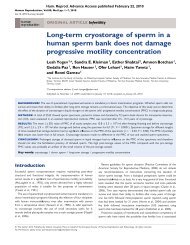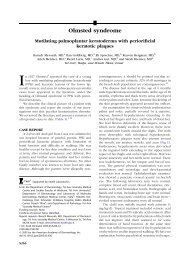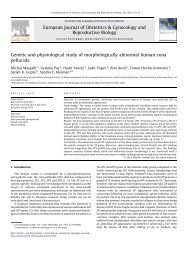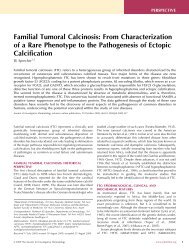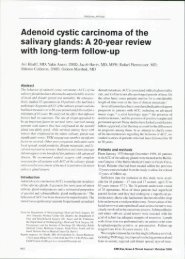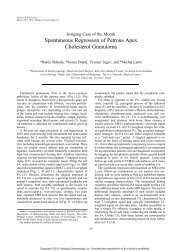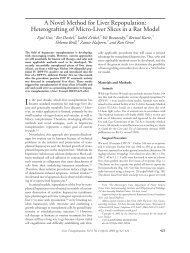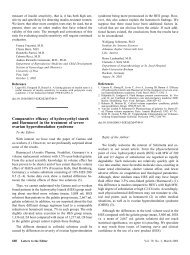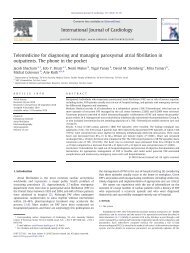Anti-proliferative effects of a novel isoflavone derivative in medullary ...
Anti-proliferative effects of a novel isoflavone derivative in medullary ...
Anti-proliferative effects of a novel isoflavone derivative in medullary ...
Create successful ePaper yourself
Turn your PDF publications into a flip-book with our unique Google optimized e-Paper software.
260 Y. Greenman et al. / Journal <strong>of</strong> Steroid Biochemistry & Molecular Biology 132 (2012) 256– 261<br />
Fig. 4. cD-tBoc <strong>in</strong>duces thyroid cancer TT cell death through the <strong>in</strong>duction <strong>of</strong> apoptosis and necrosis. (a) Effect <strong>of</strong> cD-tBoc on apoptotic cell death <strong>in</strong> cultured TT cell l<strong>in</strong>es<br />
as assessed by the detection <strong>of</strong> histone–DNA fragments, p < 0.001; (b) effect <strong>of</strong> the general apoptosis <strong>in</strong>hibitor ZV on the <strong>in</strong>hibitory effect <strong>of</strong> cD-tBoc on DNA synthesis <strong>in</strong><br />
cultured human TT cells, *p < 0.05 for the difference between cD-tBoc treated and control treated cells and # p < 0.05 for the difference <strong>of</strong> cD-tBoc treated + ZV compared to<br />
cD-tBoc treated alone; (c) effect <strong>of</strong> ZV on cD-tBoc <strong>in</strong>hibition <strong>of</strong> CK activity, *p < 0.05 for the difference between cD-tBoc treated and control treated cells and # p < 0.05 for the<br />
difference <strong>of</strong> cD-tBoc treated + ZV compared to cD-tBoc treated alone; and (d) effect <strong>of</strong> cD-tBoc on LDH activity, reflect<strong>in</strong>g cell necrosis <strong>in</strong> cultured human TT cells, *p < 0.05<br />
for the difference between cD-tBoc treated and control treated cells.<br />
already achieved at the lowest concentration tested (0.0312 �M)<br />
(Fig. 4a). Co-<strong>in</strong>cubation with the antiapoptotic agent ZV (Z-VAD-<br />
FMK) reversed the growth <strong>in</strong>hibitory effect elicited by cD-tBoc<br />
as measured by thymid<strong>in</strong>e <strong>in</strong>corporation (Fig. 4b), and CK activity<br />
(Fig. 4c), <strong>in</strong>dicat<strong>in</strong>g that cD-tBoc-<strong>in</strong>duced apoptosis is a major<br />
mechanism through which this compound retards growth <strong>in</strong> the<br />
TT cell l<strong>in</strong>e. F<strong>in</strong>ally, cD-tBoc <strong>in</strong>creased TT cell release <strong>of</strong> LDH by<br />
67% (Fig. 4d), reflect<strong>in</strong>g cell necrosis and thus <strong>in</strong>dicat<strong>in</strong>g that this<br />
is another pathway by which this compound <strong>in</strong>hibits cell proliferation.<br />
4. Discussion<br />
An <strong>in</strong>crease <strong>in</strong> calciton<strong>in</strong> secretion by normal thyroid C-cells as<br />
a result <strong>of</strong> estrogen stimulation has been demonstrated <strong>in</strong> vitro<br />
[18] as well as <strong>in</strong> animal models [19] and humans [20], thus suggest<strong>in</strong>g<br />
the presence <strong>of</strong> estrogen receptors <strong>in</strong> these cells. Normal<br />
[21] and hyperplastic C-cells [22] have been shown by immunocytochemistry<br />
to express exclusively ER�. This predom<strong>in</strong>ant ER�<br />
expression has been described <strong>in</strong>itially for <strong>medullary</strong> thyroid carc<strong>in</strong>oma<br />
samples as well [23], but subsequently ER� has been detected<br />
<strong>in</strong> most MTC samples by immunosta<strong>in</strong><strong>in</strong>g us<strong>in</strong>g different antibodies<br />
[23], or by RT-PCR [4]. In fact, as measured by quantitative<br />
real time RT-PCR, MTC samples had higher expression levels <strong>of</strong><br />
ER� mRNA than ER� mRNA, <strong>in</strong> equivalent levels to those found<br />
<strong>in</strong> normal thyroid tissue [4]. Although estrogen receptor expression<br />
has been clearly demonstrated previously <strong>in</strong> TT cells [24], here<br />
we show that ER� is the predom<strong>in</strong>ant mRNA is<strong>of</strong>orm expressed <strong>in</strong><br />
these cells. Furthermore, our results <strong>in</strong>dicate that both specific ER�<br />
and ER� agonists stimulate DNA synthesis and CK activity, <strong>in</strong>dicat<strong>in</strong>g<br />
<strong>in</strong>creased TT cell proliferation. This effect was receptor specific<br />
as MPP, an ER� antagonist, blocked the <strong>effects</strong> <strong>of</strong> the ER�-specific<br />
PPT agonist, whereas PTHPP, an ER� antagonist, blocked the <strong>proliferative</strong><br />
<strong>effects</strong> <strong>of</strong> the ER�-specific DPN agonist. Hence, despite<br />
the more pronounced mRNA expression <strong>of</strong> ER� <strong>in</strong> TT cells, both<br />
receptor is<strong>of</strong>orms significantly mediated E2 <strong>in</strong>duced proliferation<br />
<strong>in</strong> these cells.<br />
Our results are <strong>in</strong> contrast with those <strong>of</strong> Cho et al., who reported<br />
opposite <strong>effects</strong> <strong>of</strong> ER� (stimulatory) and ER� (<strong>in</strong>hibitory) on cell<br />
proliferation and apoptosis <strong>of</strong> TT cells [24]. A possible explanation<br />
to this discrepancy it that the TT cell l<strong>in</strong>e stra<strong>in</strong> used by<br />
these authors had no endogenous ER receptor expression and that<br />
proliferation studies were performed follow<strong>in</strong>g <strong>in</strong>fection <strong>of</strong> these<br />
cells with adenoviral vectors carry<strong>in</strong>g the either the human ER�<br />
or the ER� receptor, thus creat<strong>in</strong>g a more artificial experimental<br />
paradigm.<br />
Another important f<strong>in</strong>d<strong>in</strong>g <strong>of</strong> the present study is that a synthetic<br />
<strong>derivative</strong> <strong>of</strong> the is<strong>of</strong>lavone daidze<strong>in</strong>, cD-tBoc, potently<br />
<strong>in</strong>hibited TT-cell proliferation, through the <strong>in</strong>duction <strong>of</strong> both cell<br />
apoptosis and necrosis. The exact mechanisms by which this compound<br />
exerts its anti-tumoral <strong>effects</strong> have not been clarified yet<br />
although our results po<strong>in</strong>t to a predom<strong>in</strong>ant mediat<strong>in</strong>g effect <strong>of</strong><br />
ER�. This hypothesis is supported by our data show<strong>in</strong>g abrogation<br />
<strong>of</strong> the anti<strong>proliferative</strong> <strong>effects</strong> if cD-tBoc by a specific ER� antagonist<br />
but not by an ER� antagonist. Furthermore, cD-tBoc <strong>in</strong>hibited<br />
TT-cell proliferation <strong>in</strong>duced by an ER� agonist but not by and<br />
ER� agonist. F<strong>in</strong>ally, daidze<strong>in</strong>, the parent compound <strong>of</strong> cD-tBoc<br />
has been shown to have a greater aff<strong>in</strong>ity for ER� [25]. Our f<strong>in</strong>d<strong>in</strong>gs<br />
support recent data published by our group suggest<strong>in</strong>g that<br />
cD-tBoc <strong>in</strong>hibition <strong>of</strong> proliferation <strong>of</strong> the follicular thyroid carc<strong>in</strong>oma<br />
cell l<strong>in</strong>e WRO and <strong>of</strong> the anaplastic thyroid carc<strong>in</strong>oma cell<br />
l<strong>in</strong>e ARO is mediated by ER� [26]. Nevertheless, <strong>in</strong> TT cell l<strong>in</strong>es,




